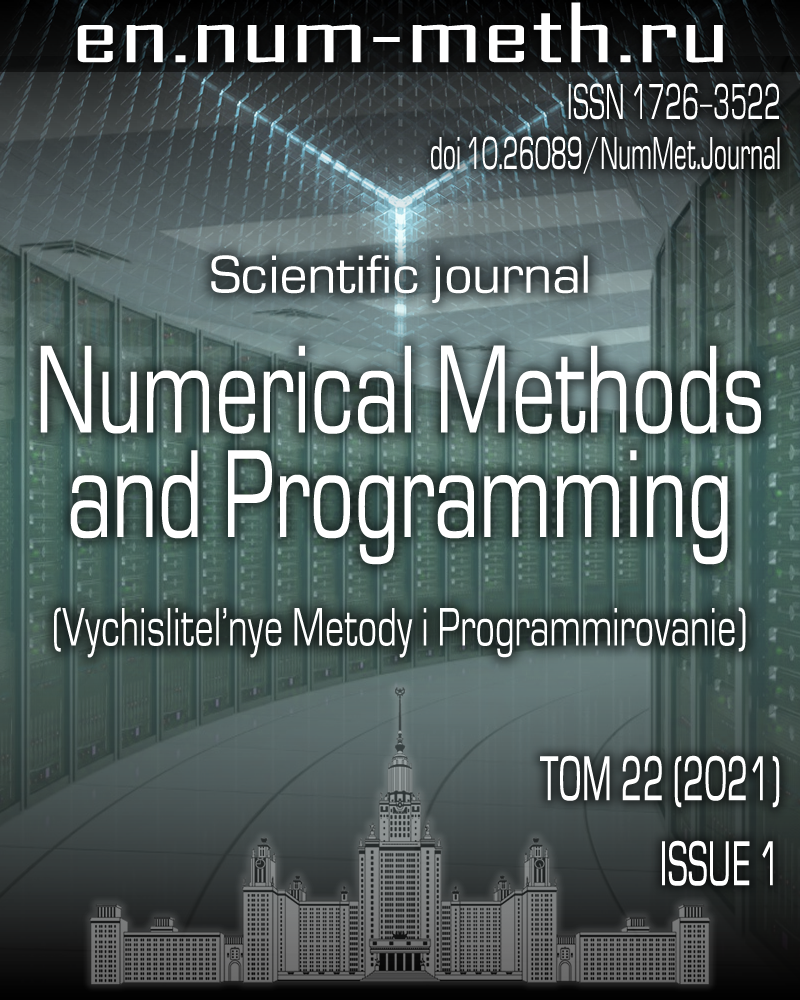DOI: https://doi.org/10.26089/NumMet.v22r105
CABARET scheme with improved dispersion properties for systems of linear hyperbolic-type differential equations
Keywords:
Abstract
A conservative-characteristic method to solve systems of linear hyperbolic-type partial differential equations is proposed. This method has the fourth order of approximation on uniform grids and the second approximation order and improved dispersion properties on non-uniform grids. The proposed method is based on the well-known CABARET scheme whose conservative phases are modified by adding anti-dispersive terms of a special type. Previously, a method with similar properties was proposed only for the simplest one-dimensional linear advection equation. The modification of the scheme allows us to improve the dispersion properties of the advection for all Riemann invariants of the system of equations under consideration at once. The scheme is non-dissipative when the monotonization procedures are not used and is stable at Courant numbers CFL ≤ 1. The accuracy of the method and its order of convergence are shown in a series of solving the problem of advection of a wave modulated by a Gaussian on a sequence of condensing grids. The proposed method is planned to be used as a basis for constructing a CABARET scheme with improved dispersion properties for systems of nonlinear differential equations.
Published
Issue
Section
References
- X.-D. Liu, S. Osher, and T. Chan, “Weighted Essentially Non-Oscillatory Schemes,” J. Comput. Phys. 115 (1), 200-212 (1994).
- C.-W. Shu and S. Osher, “Efficient Implementation of Essentially Non-Oscillatory Shock-Capturing Schemes,” J. Comput. Phys. 77 (2), 439-471 (1988).
- B. Cockburn and C.-W. Shu, “Runge-Kutta Discontinuous Galerkin Methods for Convection-Dominated Problems,” J. Sci. Comput. 16 (3), 173-261 (2001).
- J. Qiu and C.-W. Shu, “Runge-Kutta Discontinuous Galerkin Method Using WENO Limiters,” SIAM J. Sci. Comput. 26 (3), 907-929 (2005).
- C. Bogey, N. de Cacqueray, and C. Bailly, “A Shock-Capturing Methodology Based on Adaptative Spatial Filtering for High-Order Non-Linear Computations,” J. Comput. Phys. 228 (5), 1447-1465 (2009).
- V. M. Goloviznin and B. N. Chetverushkin, “New Generation Algorithms for Computational Fluid Dynamics,” Zh. Vychisl. Mat. Mat. Fiz. 58 (8), 20-29 (2018) [Comput. Math. Math. Phys. 58 (8), 1217-1225 (2018)].
- V. M. Goloviznin and A. A. Samarskii, “Difference Approximation of Convective Transport with Spatial Splitting of Time Derivative,” Mat. Model. 10 (1), 86-100 (1998).
- S. A. Karabasov and V. M. Goloviznin, “Compact Accurately Boundary-Adjusting High-Resolution Technique for Fluid Dynamics,” J. Comput. Phys. 228 (19), 7426-7451 (2009).
- V. M. Goloviznin, I. A. Korotkin, and S. A. Finogenov, “Modeling of Turbulent Natural Convection in Enclosed Tall Cavities,” J. Appl. Mech. Tech. Phys. 58, 1211-1222 (2017).
- S. A. Karabasov and V. M. Goloviznin, “New Efficient High-Resolution Method for Nonlinear Problems in Aeroacoustics,” AIAA J. 45 (12), 2861-2871 (2007).
- A. P. Markesteijn and S. A. Karabasov, “CABARET Solutions on Graphics Processing Units for NASA Jets: Grid Sensitivity and Unsteady Inflow Condition Effect,” Comptes Rendus Mécanique 346 (10), 948-963 (2018).
- M. A. Zaitsev and S. A. Karabasov, “Cabaret Scheme for Computational Modelling of Linear Elastic Deformation Problems,” Mat. Model. 29 (11), 53-70 (2017).
- V. M. Goloviznin and S. A. Karabasov, “Nonlinear Correction of Cabaret Scheme,” Mat. Model. 10 (12), 107-123 (1998).
- V. M. Goloviznin and A. A. Samarskii, “Some Properties of the Difference Scheme ’Cabaret’,” Mat. Model. 10 (1), 101-116 (1998).
- C. Abhishek, S. E. Naghibi, A. P. Markesteijn, and S. A. Karabasov, “A Fourth-Order CABARET Scheme for Computational Aeroacoustics,” (2019).
doi 10.13140/RG.2.2.28629.88805 - A. Iserles, “Generalized Leapfrog Methods,” IMA J. Numer. Anal. 6, 381-392 (1986).
- Yu. I. Shokin, The Method of Differential Approximation (Nauka, Novosibirsk, 1979; Springer, Berlin, 1983).
- V. M. Goloviznin, S. A. Karabasov, and I. M. Kobrinskii, “Balance-Characteristic Schemes with Separated Conservative and Flux Variables,” Mat. Model. 15 (9), 29-48 (2003).
- V. M. Goloviznin, M. A. Zaitsev, S. A. Karabasov, and I. A. Korotkin, Novel Algorithms of Computational Hydrodynamics for Multicore Computing (Mosk. Gos. Univ., Moscow, 2013) [in Russian].
- S. A. Karabasov and V. M. Goloviznin, “Compact Accurately Boundary-Adjusting High-Resolution Technique for Fluid Dynamics,” J. Comput. Phys. 228 (19), 7426-7451 (2009).
- C. Bogey and C. Bailly, “A Family of Low Dispersive and Low Dissipative Explicit Schemes for Flow and Noise Computations,” J. Comput. Phys. 194 (1), 194-214 (2004).
- N. S. Bakhvalov, N. P. Zhidkov, and G. M. Kobel’kov, Numerical Methods (Nauka, Moscow, 1987) [in Russian].
- N. A. Afanasiev, V. M. Goloviznin, V. N. Semenov, et al., “Direct Simulation of Thermoacoustic Instability in Gas Generators Using ’CABARET’ Scheme,” Mat. Model. 33 (2), 3-19 (2021).
License
Copyright (c) 2021 Numerical methods and programming

This work is licensed under a Creative Commons Attribution 4.0 International License.


